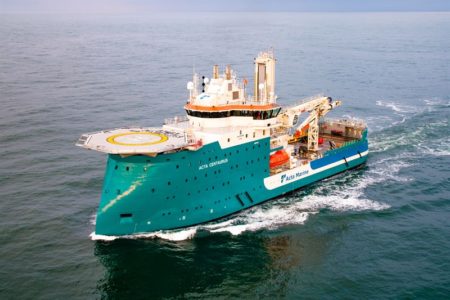August 8, 2019 – Ships today account for almost 4% of greenhouse gas (GHG) emissions. It isn’t just the carbon dioxide (CO2), but also the nitrogen oxide (NOx), and sulfur dioxide (SO2) that maritime shipping dumps into the atmosphere in making global trade possible. Ships produce 15% of NOx emissions, and 8% of the SO2 emitted by industrial sources annually. And although shipping has largely been given a longer leash and timelines to reduce its carbon footprint by the United Nations and most world governments, it is beginning to recognize decarbonizing as a priority sooner than later. That’s why the International Maritime Organization (IMO) this year amended its mandatory requirements for GHGs with the goal of reducing emissions for all new builds of container and liquid-fuel carrying vessels starting in 2022 while tackling older vessels through refits.
Hybrid propulsion systems represent an interesting technology solution for ship owners among many others including low-sulfur diesel and heavy oil-burning engines (collectively known by the acronym LSFO), gas turbines, hydrogen power, electric propulsion, and the reintroduction of sails albeit with a 21st-century high-tech twist. And for older ships operators are looking at after-combustion solutions like smokestack scrubbers, and even some with carbon capture and storage capability.
Of all these, hybrid propulsion appears in the interim to be highly attractive. Why? Because the technology which began with automobiles has matured to the point where today it is being deployed in smaller marine vessels.
What’s involved in marine hybrid propulsion systems?
They combine an electric motor, batteries, or fuel cells with traditional marine engines. That means they can be an add on to most existing shipping today. And that means with zero-emission component ships can begin to reduce GHGs significantly, with CO2 reductions of 15% according to one hybrid engine builder Wärtsilä Corporation.
Where do you find hybrid propulsion-powered ships today?
Mostly on coastal ferries, tugboats, and offshore support vessels where most trips are of a short-haul nature.
In an announcement today, Wärtsilä, a Helsinki-based company, has been chosen by an operator of 450 offshore support vessels, Acta Marine, to supply a hybrid drive, batteries, and the energy management system for its newest vessel, the Acta Centaurus. If the solution proves its worth, it could mean a dramatic overall reduction in fleet emissions for the Netherlands-based maritime operator.
What’s also interesting about the Acta Centaurus is where the ship will serve, providing offshore wind construction support. So not only will the ship produce fewer emissions, but its work with offshore wind turbines will contribute to increased renewable energy capacity.
Where else can we find hybrid propulsion on ships?
In July the first hybrid-powered cruise ship, the MS Roald Amundsen, launched its maiden voyage. The Amundsen’s power comes from a hybrid battery-liquid natural gas (LNG) engine. Royal Caribbean has three ships under construction with the first to be delivered in 2022. These are 5,000 passenger, 200,000-ton Icon-class vessels. Royal Caribbean considers Icon class to be a game-changer for cruising, dramatically reducing the company’s carbon footprint and affirming its commitment to clean-power technologies. Carnival, Costa, and P&O Cruises have also announced plans to retrofit some of their existing cruise ships to incorporate hybrid-LNG power systems.









